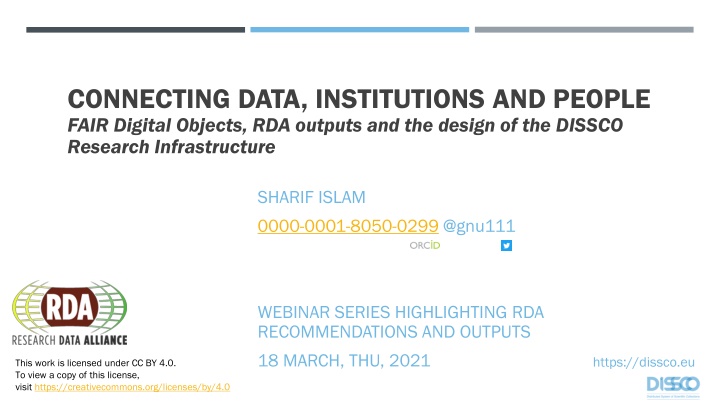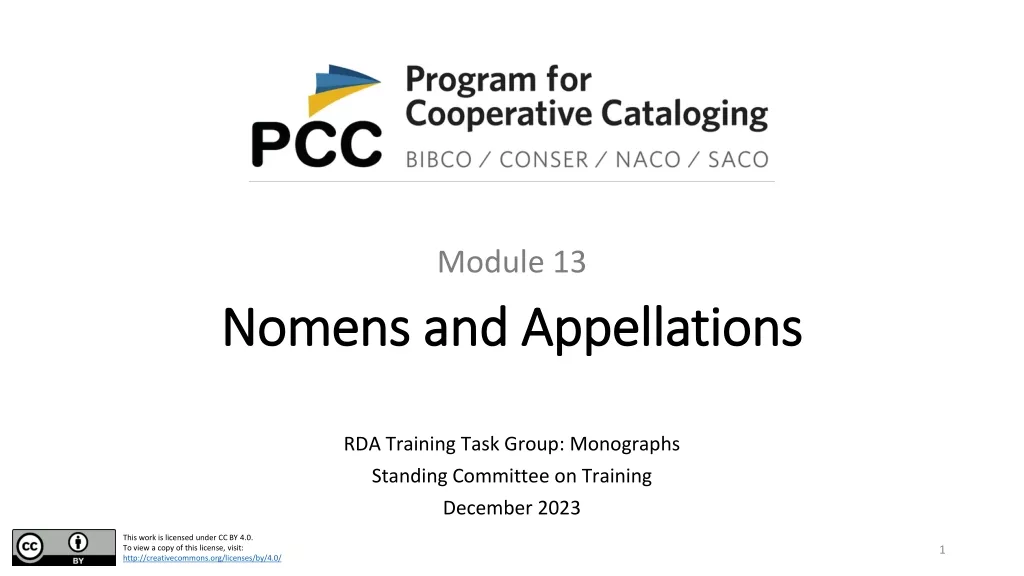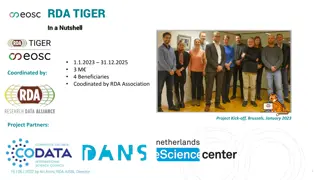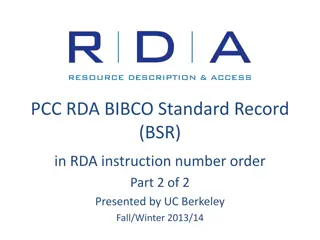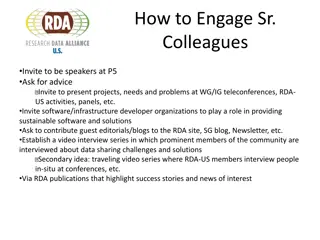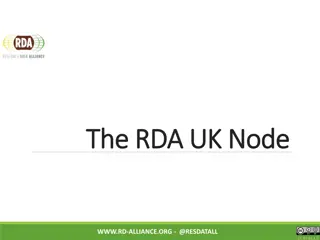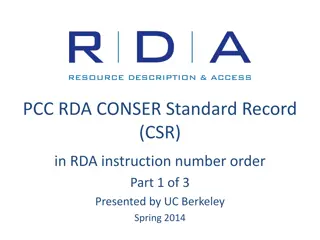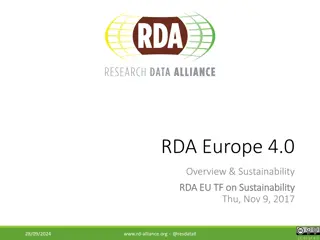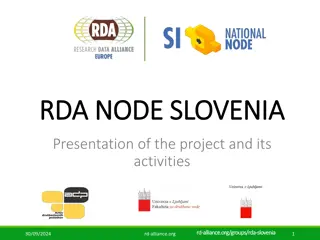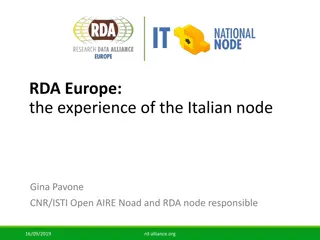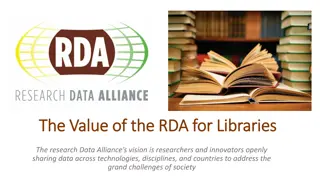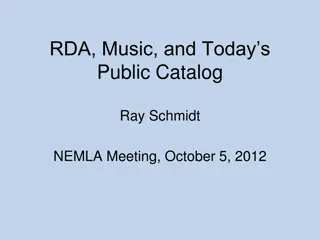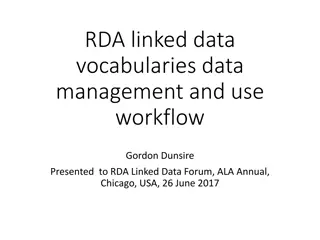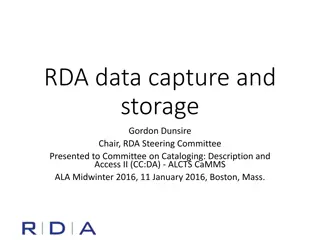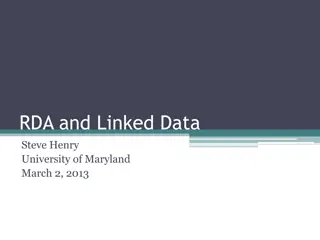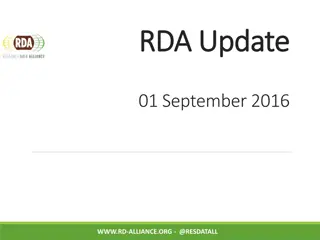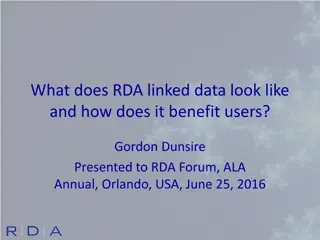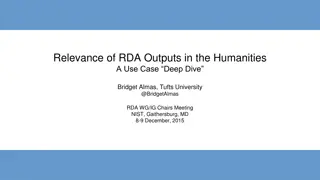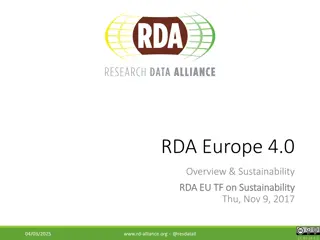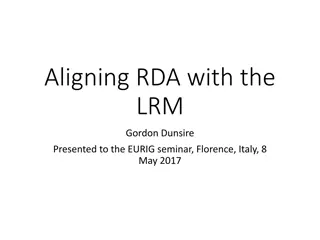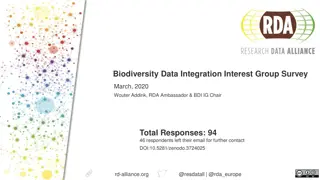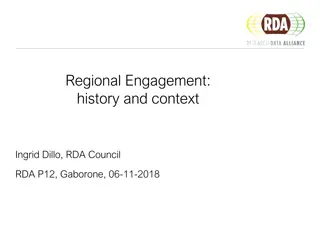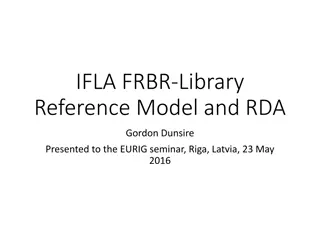Connecting Data, Institutions, and People: RDA Outputs and DISSCO Research Infrastructure
"Fair Digital Objects, new business model for European collections, research infrastructure phases, and guidelines for FAIR digital assets. Image objects highlighting RDA recommendations and outputs. Explore specimens, sequences, and more in a centralized model with shared governance."
Download Presentation

Please find below an Image/Link to download the presentation.
The content on the website is provided AS IS for your information and personal use only. It may not be sold, licensed, or shared on other websites without obtaining consent from the author.If you encounter any issues during the download, it is possible that the publisher has removed the file from their server.
You are allowed to download the files provided on this website for personal or commercial use, subject to the condition that they are used lawfully. All files are the property of their respective owners.
The content on the website is provided AS IS for your information and personal use only. It may not be sold, licensed, or shared on other websites without obtaining consent from the author.
E N D
Presentation Transcript
CONNECTING DATA, INSTITUTIONS AND PEOPLE FAIR Digital Objects, RDA outputs and the design of the DISSCO Research Infrastructure SHARIF ISLAM 0000-0001-8050-0299 @gnu111 WEBINAR SERIES HIGHLIGHTING RDA RECOMMENDATIONS AND OUTPUTS 18 MARCH, THU, 2021 https://dissco.eu This work is licensed under CC BY 4.0. To view a copy of this license, visit https://creativecommons.org/licenses/by/4.0
a new business model: ONE EUROPEAN COLLECTION ONE EUROPEAN COLLECTION 120 National Facilities 21 Countries One European Collection of scientific assets Common Collections development strategy Largest ever Largest ever formal agreement between Economies of scope and scale natural science collection facilities Centralised Centralised shared governance shared governance model Monitoring impact of collections (documenting ROI) already in place Synchronisation Synchronisation of facilities at access, Specialisation strategies (e.g. in alignment with national priorities, e.g. Smart Specialisation Strategies) data and policy level Joint Research Agendas
A research infrastructure in the making... Proposal Phase Preparatory Phase Construction Phase Transition Phase Operation with a masterplan
Guidelines to improve the Findability, Accessibility, Interoperability, and Reuse of digital assets. FAIR FAIR Digital Objects FAIR Digital Objects (FDO) bind all critical information about an entity in one place and create a new kind of actionable, meaningful and technology independent object Specimens, Collections, Sequences, Images, Publications . Collection holding institutes Collectors, Curators, Researchers, Policy makers, Technical support
https://www.nytimes.com/2021/03/01/science/bird-indonesia-babbler.htmlhttps://www.nytimes.com/2021/03/01/science/bird-indonesia-babbler.html
http://orientalbirdimages.org/search.php?Bird_ID=1428&Bird_Image_ID=28450http://orientalbirdimages.org/search.php?Bird_ID=1428&Bird_Image_ID=28450
{ What "id": "20.5000.1025/unique_uuid_string", "typeName": "Digital Specimen", "authoritative": { "modified": "2021-03-02T14:10:20.824Z", "physicalSpecimenId": "https://bioportal.naturalis.nl/specimen/RMNH.AVES.89412", "institution": [ "Naturalis Biodiversity Center", "https://ror.org/0566bfb96" ], "recordedBy": [ "Carl Schwaner", "https://bionomia.net/Q12478384", ], "name": [ "Black-browed Babbler", "Malacocincla perspicillata (Bonaparte, 1850)", "https://data.catalogueoflife.org/dataset/2242/taxon/3XKH8" ] } } When What Where Who What
Globally Unique and Resolvable Persistent Identifier { "id": "20.5000.1025/unique_uuid_string", "typeName": "Digital Specimen", "authoritative": { "modified": "2021-03-02T14:10:20.824Z", "physicalSpecimenId": "https://bioportal.naturalis.nl/specimen/RMNH.AVES.89412", "institution": [ "Naturalis Biodiversity Center", "https://ror.org/0566bfb96" ], "recordedBy": [ "Carl Schwaner", "https://bionomia.net/Q12478384", ], "name": [ "Black-browed Babbler", "Malacocincla perspicillata (Bonaparte, 1850)", "https://data.catalogueoflife.org/dataset/2242/taxon/3XKH8" ] } } Provenance Physical data curation Unique Identifier for Institution Unique Identifier for people Building Links
FAIR DIGITAL OBJECT (historical context) Digital Object: A digital object is a data structure whose principal components are digital material, or data, plus a unique identifier for this material, called a handle Kahn and Wilensky, 1995 (http://www.cnri.reston.va.us/k-w.html). FAIR (Findable, Accessible, Interoperable, Reusable) - Wilkinson et al. 2016. Digital Objects have the built-in capability to implement FAIR data George Strawn, 2019. FAIR Digital Object ..is a stable actionable unit that bundles sufficient information to allow the reliable interpretation and processing of the data contained in it - De Smedt, K., Koureas, D. and Wittenburg, P., 2020. More information: https://fairdo.org
A Digital Object oriented approach for Natural Science Collections data: A Digital Object oriented approach for Natural Science Collections data: Vision for an endless number of levels of abstraction Vision for an endless number of levels of abstraction
DIGITAL SPECIMEN RDA Data Foundation and Terminology WG Data Fabric and Terminology IG Adoption of Digital Object Architecture Image credit: Alex Hardisty
DIGITAL EXTENDED SPECIMEN RDA Data Foundation and Terminology WG Data Fabric and Terminology IG Adoption of Digital Object Architecture Image credit: Wouter Addink The concept of the extended specimen, introduced by Mike Webster (2017), elevates and expands the physical specimen with an augmented digitized specimen record by associating genotypic, phenotypic and environmental data types. Ref: https://bcon.aibs.org/ Global Consultation: https://discourse.gbif.org
20.5000.1025/unique_uuid_string RDA PID Kernel WG { "typeName": http://hdl.handle.net/21.T11148/627a5b7620b1471aa945 ", Location: dissco-repo.eu "modified": "2021-03-02T14:10:20.824Z", RDAKIProfileType":http://hdl.handle.net/20.5000.347/rdastrawman } Persistent Identifiers and Kernel Information - Small amount of information stored in PID record - Structured record with attributes whose semantics are retrievable in machine-interpretable form - Kernel Information can convey accessibility information thus making it easier for accessing the digital object - Can include privacy or legal restrictions on a data object
20.5000.1025/unique_uuid_string { RDA Research Data Collection WG "physicalSpecimenId": "https://bioportal.naturalis.nl/specimen/RMNH.AVES.89412", } AVES Naturalis - Zoology and Geology catalogues Naturalis Extinct Bird Aggregation of digital objects Borneo, Indonesia - Collection of Digital Specimens - Organizing specimens into specific kinds of collection (zoology, botany, etc.) - In the digital world, however, the notion of a collection is far more flexible - Objects can be members of multiple collections simultaneously
20.5000.1025/unique_uuid_string "recordedBy": [ "Carl Schwaner", "https://bionomia.net/Q12478384", ], RDA/TDWG Metadata attribution WG Metadata attribution and use of PROV entities Many people can be associated with a specimen: the collector, curator, determiner, annotator, mounter, transcriber, digitizer, imager and georeferencer. Groom et al. (2019:12 2019:12) PROV: the agent (humans or machines), the activity (or action) they perform, and the digital or physical object (entity) they are curating/processing
20.5000.1025/unique_uuid_string "recordedBy": [ "Carl Schwaner", "https://bionomia.net/Q12478384", ], RDA/TDWG Metadata attribution WG - Sabina Leonelli (2016: 188 makes the point that to support the scientists, we must understand the processes behind successful empirical research. - Metadata attribution and use of PROV entities provide technical foundation to bring these processes to the forefront of supporting and sustaining a research infrastructure. 2016: 188 189 189) in Data-centric biology: A philosophical study
- - "id": "20.5000.1025/ "id": "20.5000.1025/unique_uuid_string - - PID Service - Predictable resolution - Findability unique_uuid_string RDA FAIR data maturity model WG Guidelines and specifications to assess the DiSSCo FAIR implementation plan. - - " "typeName typeName": "Digital Specimen ": "Digital Specimen - Metadata schema with relevant attributes - Object classification - Minimum Information standard for Digital Specimens (MIDS) - Interoperability and reusability
DIGITAL SPECIMENS Digital Specimen is a particular type of FAIR Digital Object. Digital Specimens are more than just digital representations. They act as digital containers and processable digital twins on the Internet for physical specimens in collections.
LESSONS LEARNT We need to focus on demos and targeted proof of concept works along with the design. Reaching out to the user community to identify edge cases (workshops, hackathons). Collaborate and learn from other domains/research infrastructures.
ACKNOWLEDGEMENTS Islam, S., Hardisty, A., Addink, W., Weiland, C. and Gl ckler, F., 2020. Incorporating RDA Outputs in the Design of a European Research Infrastructure for Natural Science Collections. Data Science Journal, 19(1), p.50. DOI: http://doi.org/10.5334/dsj-2020-050 RDA Europe 4.0 (https://cordis.europa.eu/project/id/777388 Grant Agreement No. 777388). DiSSCo Prepare (https://www.dissco.eu/what-is-dissco-prepare/ ) is funded by the Horizon 2020 Framework Programme of the European Union (H2020-INFRADEV-2019-2020 Grant Agreement No. 871043) Image attribution: By the author and the DiSSCo Technical Team (except where otherwise noted) Stephanie Hagstrom and RDA-US for organizing this webinar
